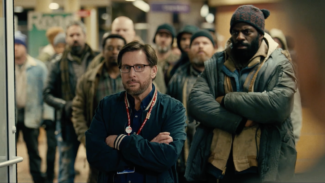The Public (Emilio Estevez, 2018): USA
Reviewed by Brianna Franklin. Viewed at the Santa Barbara International Film Festival 2018, Arlington Theater.
The Public, a film directed by Emilio Estevez (Bobby, The Way), is a piece that encapsulates an issue that has become epidemic. Not that the general population would know. Set in a Cincinnati public library, the film explores what it means what it means to be homeless, as well as what it means to do a job you didn’t sign up for. This film attempts to deal with an issue in both a broad sense, as well as a personal one. Because of this dichotomy, there are aspects of the film that miss the mark.
Estevez takes on the role of Stuart Goodson, the protagonist, a librarian who gets more than he bargains for. The film is filled with a impressive ensemble cast including, Christian Slater (Heathers, Mr. Robot) as Josh Davis, a self-obsessed prosecutor who is running for mayor, Alec Baldwin (Glengarry Glen Ross, 30 Rock) as Detective Bill Ramstead, a crisis negotiator with a missing drug-addict son, Michael Kenneth Williams (The Wire, Boardwalk Empire), as Jackson, a homeless veteran, and Taylor Schilling (Orange is the New Black, The Lucky One) as Angela, Goodson’s neighbor who is a recovering alcoholic.
The film begins with a black and white sequence seemingly from the 1950s. Cut to: outside the library, where a crowd of people wait for the doors to open. Stuart Goodson walks into work, as he does every day. We meet other librarians and library workers including: Anderson the head of the library, played by Jeffrey Wright (Angels in America, Westworld). As the film progresses, we see the daily struggles of Goodson, including dealing with a singing, naked homeless man. Later, Goodson is called into Anderson’s office to meet with Josh Davis. The library is being sued by a homeless man who was asked to leave the building because of his odor. The marks the beginning of tension between Goodson and Davis. Later, due to the severity of the cold, the group of homeless people at the library decide that they will not leave when the building officially closes. Goodson gets caught in the middle, and they end up staging a sit-in. Throughout the rest of the film, a series of misunderstandings and miscommunications mark the relationships between the homeless and law enforcement, the library and the city, as well as many others.
The film was shot digitally, but with a staticky quality of film. Cinematographer Juan Miguel Azpivoz and editors Richard Chew and Yang Hua Hu create a sense of intimacy with this quality. This lends itself to the personal stories Estevez attempts to tell. Part of the issue with the film is that Estevez tries to straddle the line between individual stories and a political call to action. That is a big undertaking for a 2-hour film. The camera quality feels intimate in the littler stories, and out of place as a full picture. Because of the large cast, it is hard to get to know each of the characters in the close way that was attempted. On the other hand, the call to arms isn’t quite large enough. The story only scratches the surface of the many issues surrounding Cincinnati and the public library. Overall, the film is in need of either some narrowing, or some broadening, but not both.
The Public is a good attempt at dichotomizing personal characters and larger issues, but doesn’t get it quite right. It is worth watching for the humor in tough situations, beautiful cast, and great cinematography, but not for answers to questions, both large and small.
About this entry
You’re currently reading “The Public (Emilio Estevez, 2018): USA,” an entry on Student Film Reviews
- Published:
- 02.12.18 / 12pm
- Category:
- Films, Santa Barbara Film Festival 2018

5 Comments
Jump to comment form | comments rss [?]